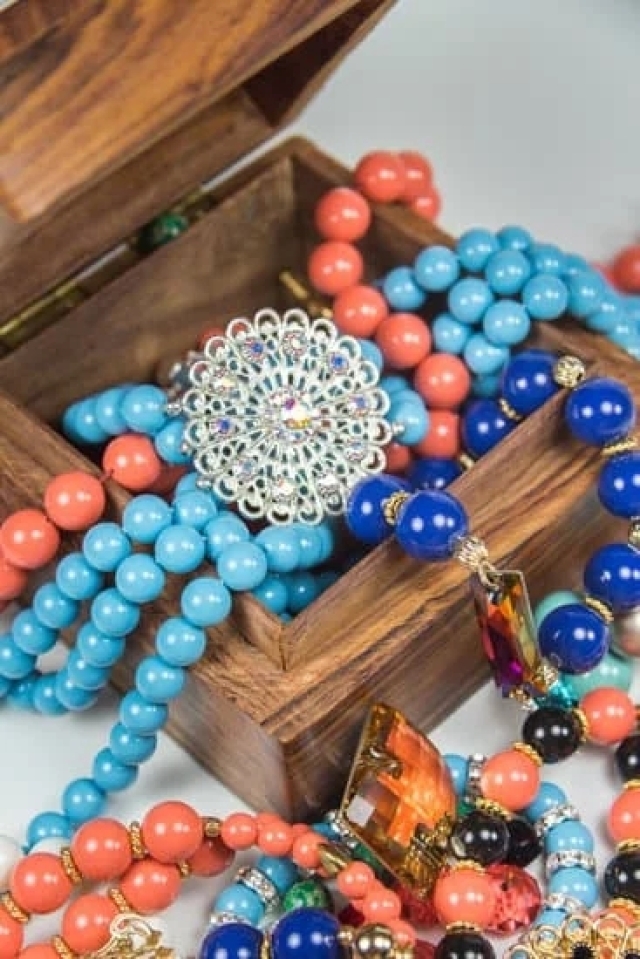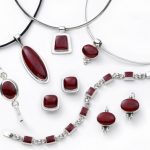Gold plating is a process of applying a thin layer of gold over another material, usually silver or brass. This technique is typically used to give jewelry, coins and other items a more ornate and luxurious look. The amount of gold plating varies depending on the desired outcome.
Though it offers great decorative appeal, gold plating is not the most durable of coatings and can become discolored or worn over time due to exposure to everyday elements such as air and moisture. Thankfully, there are methods for restoring discolored gold plated jewelry back to its original gleam without having to replace it entirely.
The Different Types of Gold Plating
There are several different types of gold plating that may be used on jewelry items: electroplating, immersion (tank) plating and jet plating. Electroplating uses an electrical current that pushes positively-charged metal ions onto the object being plated; this method is cost-effective but not incredibly long lasting.
Immersion (or tank) plating involves completely submerging an object into a bath of gold-infused solution to create a thicker coverage than electroplated layers; this technique creates items with more longevity than its counterpart. Jet Plating offers very precise results thanks to automated equipment controlled by computers; many new products out there today use this type of plating for superior durability.
How To Restore Discolored Gold Plated Jewelry
Fortunately, there are several steps you can take in order to restore the shine and luster lost from discoloration. Firstly it’s important to start by removing any dirt or grime buildup that may have caused discoloration in the first place – warming some soapy water then soaking your pieces in it should do the trick.
Secondly, gently scrape off any tarnish or corrosion with a soft cloth – don’t rub too hard as this could further damage your delicate pieces. Lastly, use a polishing cloth specifically designed for reviving dulled metal surfaces; these will help create a lasting shine while also protecting them against future wear & tear caused by contact with air and moisture over time if properly cared for after each use.
Identifying When Gold Plating Becomes Discolored
Discolored gold plated jewelry is a common issue that many face. Although gold plating can make pieces of jewelry look appealing, it must be taken care of properly in order to keep its beautiful luster. Unfortunately, many people miss these steps and find their gold plating is discolored. Recognizing when it happens and understanding the possible causes are important first steps to repairing your jewelry.
There are several signs to look out for that indicate discoloration on your gold plated jewelry. Usually, the signs will appear as slight changes in the color of the metal or the stones set into it.
You might find a gray or bronze tinge starting to appear throughout or even patches where it looks much darker than before. In extreme cases, you may notice flaking as well which usually indicates an accelerated form of corrosion from wear and tear or reactions with other metals present nearby.
Understanding what caused this discoloration is also essential for repairing your jewelry properly so that it does not happen again in the future. There could be a variety of reasons why this has happened, and two of them being contact with sweat and other acidic liquids, such as perfumes or even something like swimming pool water.
The combination of moisture and acids creates a perfect breeding ground for tarnishing agents which leads to darkened spots on your jewelry over time if not properly cared for. Taking off gold plated jewelry while playing sports, exercising, bathing, etc., is recommended in order to extend its beauty longer.
Preparation
Before you start repair to discolored gold plated jewelry, it is important to gather the right supplies and tools. Microfiber cloth is ideal for polishing the jewelry as these are suitable for fragile surfaces.
A soft-bristled toothbrush or an old (and very clean) paint brush can also be used to help lift dirt of difficult-to-reach areas. It is best to use a mild soap such as ivory, castile or liquid dish detergent in order to minimize risk of damage, and some recommend that a bowl of warm water should be used when cleaning.
In terms of safety measures, it is important to use protective eyewear when handling chemicals as this will protect your eyes from any potential irritants that may come into contact with them. It is also recommended to wear rubber gloves for additional protection whilst conducting repairs as this will prevent any dust and debris from entering your skin.
For more stubborn stains and discolouration, there are other products available which can help restore its shine and colour. Metal polish specifically designed for gold plated items can be used on the jewelry after careful consideration of instructions given on the product’s label – simply apply the polish with a lint-free cloth. Alternatively, lemon juice can be poured onto the surface in small quantities before rinsing it off with water and thoroughly drying afterwards.
Testing for Tarnish Resistance
When it comes to gold plated jewelry, one of the most important things to consider is how well your pieces will stand up against tarnishing. Tarnish can appear on jewelry due to age and environmental factors, causing the gold plate to develop a discoloration that no one wants. Fixing this type of discoloration is possible if you know what steps you must take and have an understanding of tarnish resistance properties.
To start understanding how your gold plated jewelry tolerates tarnish, it’s important for consumers to understand the concept of “tarnish resistance” when reviewing product or manufacturer descriptions as this will give them an indication as to whether their gold plated jewelry will hold up in various conditions or not.
Depending on the material used, whether it’s 18k, 24k gold plating or electroplating methods, each of these will yield different quality results; therefore needing different levels of care and attention.
Furthermore, depending on a customer’s lifestyle there are several tests they can use in order to assess the quality of their gold plated jewelry. These tests include checking for signs of fading after prolonged exposure to light sources such as sun rays or UV lamps, seeing if any scratches occur with everyday wear and tear, as well as washing with acidic solutions such as soap and water to measure colorfastness.
It is also important for customers to avoid wearing their rings or necklaces in locations such as hot tubs, swimming pools etc.,as high levels of chlorine may cause oxidation which lead directly to the jewelry losing its lustre and possibly discoloring.
In conclusion, by having an understanding about tarnish resistance and familiarizing yourself with what will make your gold plated pieces durable enough for everyday wear and tear you can help keep your pieces looking beautiful year round.
Cleaning the Gold Plated Jewelry
Before you repair discolored gold plated jewelry it is important to clean the piece as best you can to remove any grime or oxidation. There are various types of cleaners suitable for use on gold-plated jewelry. Depending on the type of metal and its condition, different techniques may be used.
For example, gold-filled items should not come in contact with harsh chemicals, so only mild soaps or detergent solutions should be used. As well, ammonia should not be used at all on gold-filled jewelry. However, silver-plated jewelry may benefit from a soak in hot water containing one tablespoon to one cup of baking soda per gallon of water.
Polishing cloths are an ideal choice for cleaning soft metals like silver and gold, as they contain no abrasives and will not damage the delicate surface; this includes gold plated jewelry pieces. When using a cleaning cloth, work gently in circular motions and always go with the grain of the metal to prevent scratching or dulling the finish. No force or pressure should be applied as this can cause unnecessary damage to plated metals (especially gold).
In terms of dipping-type cleaners for your gold plated jewelry, these solutions can effectively restore color but must be done with extreme care-preferably by a professional-due to their acidic properties. Jewelers’ rouge, available at most craft stores and some hardware stores, will often remove tarnish from especially fragile pieces; all that is required is rubbing in small circles on the metal surface with a damp cloth until a shine appears.
Freund’s Jewelry Cleaner is another type specifically formulated for silversmiths that produces quick results without damaging the metal’s protective layer although it’s necessary to rinse extremely well after use due its alkaline content (it contains sodium hydroxide).
Replacing the Gold Plate
When it comes to repairing discolored gold plated jewelry, the best option is often to just replace the plating. Most jewelers will offer a variety of gold plating options, such as 24 Karat Gold, 18 Karat Gold and 18 Karat Rhodium plating. There may also be other alternatives available depending on the specific piece of jewelry.
When choosing a type of gold plating, it is important to identify what type of metal your jewelry is made out of. For example, if it’s a silver-based piece you want to choose with a silver-based plating – usually both 24K gold and 18K gold are fine for this material.
It’s also worth considering whether or not you plan on wearing the jewelry in more rugged situations which could require additional protection from tarnishing or scratching. If so, then rhodium plating may be the right choice for you due to its added durability benefits.
The process of replacing the gold plate requires that your pieces are professionally cleaned before applying any new plating layer. This cleaning should give your jewelry an extra sparkle by removing any dirt that has accumulated over time and improving its overall appearance. It can also help ensure that when new layers are added, they adhere properly without causing damage to your jewelry during application.
During this step, it’s important to make sure that no chemical cleaners or polishes are used which could potentially further etch away at any existing metal components of your piece over time. Specific techniques vary but often involve a combination of chemical baths and high pressure water washing methods which keep the underlying material from being damaged while still achieving a thorough cleaning process overall.
Preserving the Gold Plate
One of the best ways to preserve gold plated jewelry is regular maintenance and cleaning. It is important to give your jewelry a quick clean after each wear. This can easily be done with warm water, a mild detergent, and a soft cotton cloth or toothbrush.
Lightly scrub and rinse the jewelry in a gentle manner. Once finished, use a soft dry cloth to buff and remove any excess moisture from the surface of the jewelry. When storing your gold plated jewelry for longer periods of time, always make sure to store it in an airtight container or bag that will prevent oxidation from occurring.
If discoloration does occur due to oxidation or tarnishing, there are several home remedies available utilizing common household products that can restore the gold plate back to its original shine. One popular method for cleaning discoloured gold plated jewelry is using one part ketchup mixed with one part cornstarch into paste form, then gently rubbing it onto the affected area with a damp cloth before rinsing off with warm water.
Alternatively using baking soda or cream of tartar mixed with either vinegar or lemon juice and some warm water also makes an effective solution when rubbed lightly on the discolored metal using a damp cloth.
In cases where more serious damage has occurred such as heavy indentations or extreme tarnish forming a thick layer on top of the gold plating, electrolysis re-plating might be necessary.
This method involves dissolving metal particles through electricity being passed through them and reapplying fresh layers of metal onto the jewelry pieces; typically done so by professional jewelers for best results as special chemicals are needed as well as specialized machinery required in this process which may not be easily accessible at home.
Conclusion
In conclusion, with some time and patience, it is possible to repair discolored gold plated jewelry. Clean the jewelry using a cloth or q-tip dipped in vodka, rubbing alcohol or silver dip. Then polish with a damp cloth to restore shine. To add extra protection, use a specialized metal cleaner or toothpaste to polish the item. Through this process you can remove scratches and extend the life of your discolored gold plated jewelry.
For optimal maintenance and prevention of discoloration in gold plated jewelry, proper care should be taken when handling these items. Always take off the item when taking a shower, swimming or engaging in any other activity that could cause perfumes, dirt or lotions to build up on your jewelry. Refrain from wearing the item while cleaning around the house as well to avoid accidental contact with harsh cleaners.
Furthermore, store your items in separate pouches as they tend to rub against each other forming an unattractive patina which will darken gold plating. Lastly, when not being worn keep your item away from direct sunlight as UV rays can lead to further discoloration and damage over time.
By following these steps you will be able to both repair and protect your gold plated jewelry for years to come.

Welcome to my jewelry blog! My name is Sarah and I am the owner of this blog.
I love making jewelry and sharing my creations with others.
So whether you’re someone who loves wearing jewelry yourself or simply enjoys learning about it, be sure to check out my blog for insightful posts on everything related to this exciting topic!





